
“Skye” Egg tempera/oil, acrylic, collage, mixed media on canvas. 68 x 46cm
Rebecca Gabriel
Rebecca Gabriel is a prominent USA figurative artist. She holds an MFA from the University of Massachusetts in Amherst and had also studied in Europe. Her painting often utilizes the Renaissance tradition of egg tempera, oil paints, and glazes, along with an acrylic pouring medium.
As a result, these portraits combine traditional representations with the “random” and expressive effects of high-flow paint. In addition, Gabriel employs collages in various interpretations of a subject, synthesizing realism and abstraction into a cohesive, expressive whole.
Gabriel had exhibited in a variety of high-profile exhibitions, including the recent XII Florence Biennale in Italy. A one-person retrospective of her work was held at the Rogue Gallery and Art Center in Medford, Oregon.
Her work has also been exhibited at the Schneider Museum of Art, Ashland, OR; Denver Art Museum, CO; De Cordova Museum, MA; Oakland Museum, CA; Herbert F. Johnson Museum, Cornell University, NY and more.
Her art has received numerous awards. Some notable ones are the First Award, Henry Hopkins, “All California Art Exhibition,”; Finalist in Artist’s Magazine, and the Jurors Choice award in the “Human Form” exhibit, Newport Visual Art Center, OR.
Gabriel’s work was selected for an extended loan in the Executive Chairman’s office at the National Endowment for the Arts in Washington, D.C.
Gabriel has also been awarded a Massachusetts University Fellowship, as well as a Haines Foundation grant. Her work is featured in Calyx, Studio Visit, and American Artwork magazine.
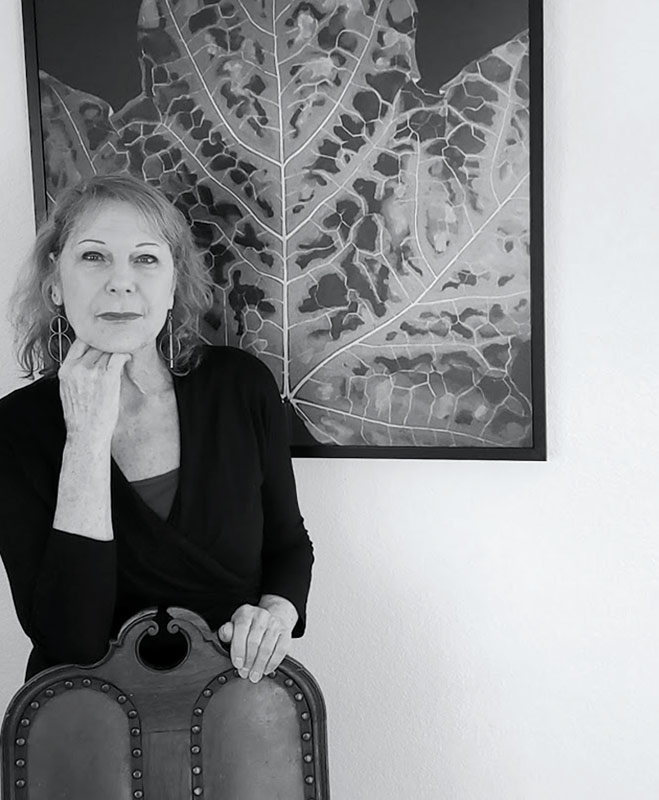
Art Market: Hello, Rebecca! It’s a pleasure to have you in the magazine. We find your work fascinating; I can’t wait to discuss your unique techniques and the way you’ve developed your style; But, first, please tell our readers about your background. What made you delve into the art field?
Rebecca Gabriel: Thank you, Jasmine. At a young age, making an image seemed like a magical power. Though I was a good student, art was always what I did best and loved most. After receiving a Bachelor of Arts degree in painting from the University of California, I set up my first art studio in Denmark and traveled extensively in Europe to visit some great museums. I had minored in Art History, and experiencing these museums confirmed and surpassed my expectations. The art seemed to speak directly to me and appeared to be the pinnacle of humankind’s achievement. I felt personally connected in such a way that I was compelled to dedicate myself to art.
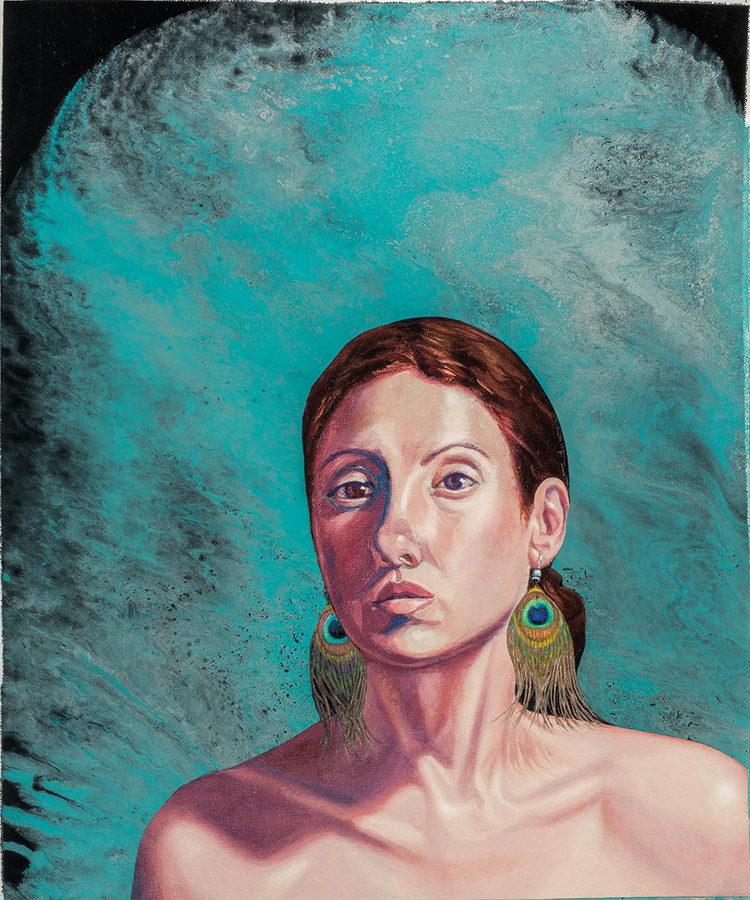
“Darrah” Oil, acrylic, collage, mixed media on canvas.
59 x 48cm
A.M.: You had studied art in both Europe and the U.S. What kinds of differences did you find studying in these two different locations? Which one did you prefer?
R.G.: Yes, as I mentioned, I received my Bachelor of Arts degree in painting and my Master of Science degree in art education in Boston, and a Master of Fine Arts in Painting in Amherst, Massachusetts. Years later, I went on to study old master painting techniques in Austria with Michael and Ernst Fuchs through the Naropa Institute in Boulder, Colorado. Between my education in the United States and Europe, the emphasis and curriculum were completely different. My studies in the United States had provided me with a deep exposure and understanding, not only of art history but of contemporary art, too. Innovative perspectives and creativity were stressed, encouraging me to take risks and break the rules.
Strangely, my cutting-edge studies in America gave me the confidence and backbone to pursue my inherent interest in figurative painting, which was NOT promoted at the time. I was determined to paint the figure and knew I was not proceeding with a retrograde naivete.
I returned to Europe to study in Vienna because I needed a technique. Unfortunately, the art institutions in the U.S. had given me little practical training. Working in America, I was often frustrated – technically.
I struggled and felt that I had to clumsily “re-invent the wheel.” My studies in Austria changed all that. I am grateful for both the U.S. and European approaches. Together, they created a gestalt in me, that had continued leading me forward, opening doors of creativity. Because of this circuitous route, I am neither academically nor commercially trained and have been able to amalgamate old master techniques with my already embedded contemporary sensibility.

“The Dreamer” Egg tempera/oil, collage, mixed media on canvas board. 61 x 46cm
A.M.: Your painting often utilizes the Renaissance tradition of egg tempera, oil paints, and glazes along with an acrylic pouring medium. This is quite a unique technique, not very common by most contemporary artists. Why did you choose this technique – once used by art legends, but forgotten since – of all possibilities?
R.G.: I am blessed to have access to both Renaissance painting techniques and cutting edge high flow acrylic techniques. I will describe this in more detail later. For now, suffice to say, the technique proceeds from the vision.
As a figurative artist, I pursued Old Master painting methods, because that is what my subject required, or, rather, demanded. I began, just out of college, painting the figure in flat acrylic paint, partly because I did not know how to create gradation, luminosity, or volume. Ultimately, I was able to pursue and acquire the necessary technical tools to do that kind of justice to my subject.
On the other end of the spectrum, I was striving to discover an emotionally expressive way of painting that would go beyond traditional portraiture. Eventually, I began using collage and combining these disparate elements: the controlled realism and the chaotic abstract. These two modalities, seemingly opposites, found a way to come together in a synergistic expressive, and innovative form.
A.M.: How has your practice changed over time? Do you feel a development from your early stage as an artist until now?
R.G.: I have been able to work consistently as an artist for decades. I am always challenging myself, both in terms of ability and vision. And, hopefully, over time, one acquires expertise and confidence. Perhaps, because of my early epiphanies in the Prado, Kunsthistorisches in Vienna, Statens Museum for Kunst in Copenhagen, etc., I am always trying to raise the bar. As Robert Browning wrote, “Ah, but a man’s reach should exceed his grasp, Or what’s a heaven for?” That is my motto.
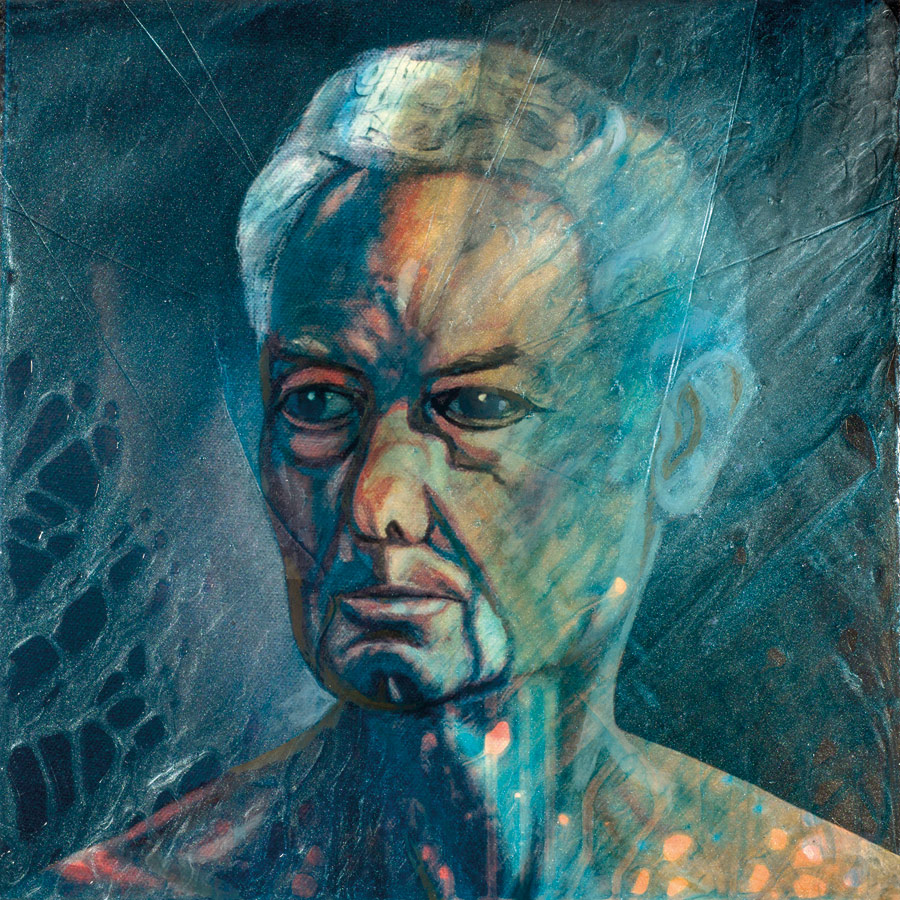
“Howard’s Ghost” Oil, Acrylic, Mixed media on Panel.
41 x 41 cm.
A.M.: On the one hand, you use a very traditional “serious” technique, used by the Italian masters. On the other hand, your work is very young and contemporary, dynamic, and emotional.
Tell us about the hidden story behind your work.
How would you describe your style?
R.G.: Every artist is unique and is a product of his or her time. I have been fortunate in that I have been able to draw, both inspiration and technique, from the Old Masters, but also a fearlessness in terms of using contemporary materials and methods. As artists, we have tremendous freedom to explore many possibilities.
Perhaps, I am like one of those Russian dolls that keep opening up into smaller and smaller beings within beings. By going deeper, ironically, I find greater expansiveness. The traditionally painted figure is my “fixed star” around which I explore the deep space of transformation, dream, passion, and a galaxy of emotion. I call my new series, “Altered States.”
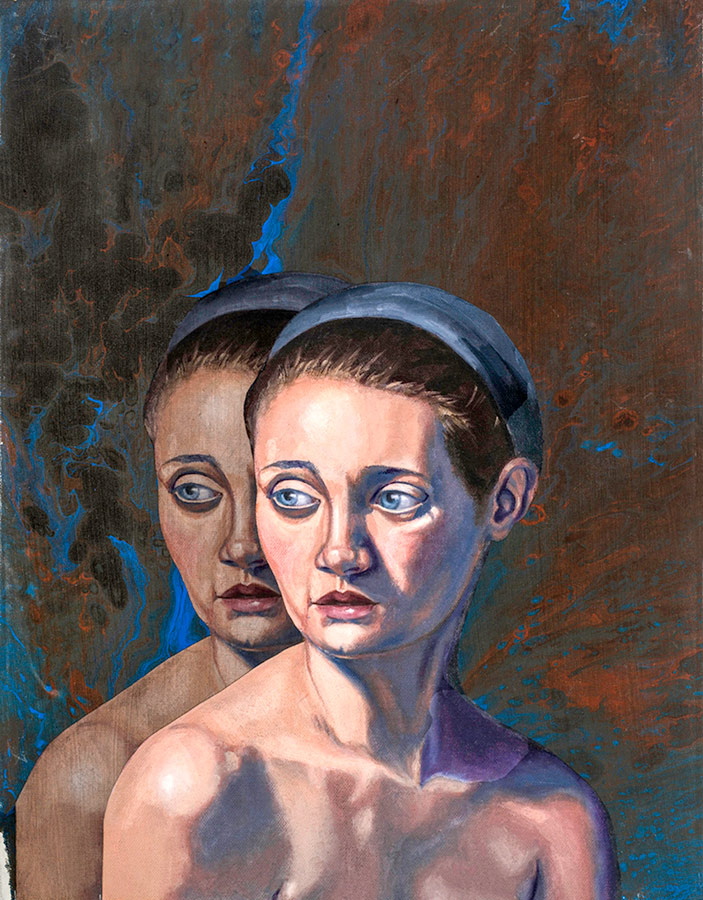
“Twins” Oil, Acrylic, Collage, Mixed media on canvas.
61 x 46 cm
A.M.: Which artists influenced your style?
R.G.: Yes, so many artists have inspired me. To name a few: Jackson Pollack, Vermeer, Andrew Wyeth, Rembrandt, Lucian Freud, Frida Kahlo, Velasquez, Van Gogh, Picasso, da Vinci, Rogier van der Wyden, and the van Eycks. Their work is like a rosary of images, which I turn over and feel in my mind’s eye.
A.M.: Can you describe the workflow, from the inspiration stage to the final artwork? Where the inspiration comes from?
R.G.: Yes, this part fascinates me – how I got from the original egg tempera/oil painting to this current series. Firstly, through time, I noticed that my figurative paintings worked not only as a whole but also that specific DETAILS of these large pieces could also be standalone paintings. My large egg tempera/oil figurative pieces take
a considerable amount of time to create, and as I develop and work on them, many aspects or possibilities emerge. I began thinking of my large pieces as being more like books – a whole world in themselves, with many layers, both literally and narratively.
In 2014, I received a Haines Foundation grant to explore the idea of multiples in my work. I began extrapolating various details from my paintings and drawings. I would then superimpose or combine these standalone DETAILS with various thematic or graphic components, often using collage. In this way, I can reshape my cast of characters into different narratives, in a fluid process. Because I extrapolate images using reproductions, the original oil/egg tempera painting remains intact. Thus, I can be experimental and risk-taking with these “Multiples.” Many transformative possibilities began to open up. I took a workshop in Denver, using the newly refined Golden High Flow paints.
I loved the expressive and accidental qualities of the process on canvas. I realized I could also print my recently extracted images on canvas, cut them out, and collage them onto the high flow surfaces. Then I discovered I could also pour the high flow paints directly over the intact printed image and see what happened, as in “Vapors,” or combine both approaches. While collaging, I could turn the cutout portrait image in any direction, and thus change its orientation. If I want, I can photoshop the extrapolated images, and therefore come up with black and white versions, or employ manipulated tones. As for inspiration, my newly developed technique has proven to be compelling and irresistible. I’ve had many failures, but the magic and versatility of the series has sustained my excitement. It has led me to an expressive and prolific landscape.
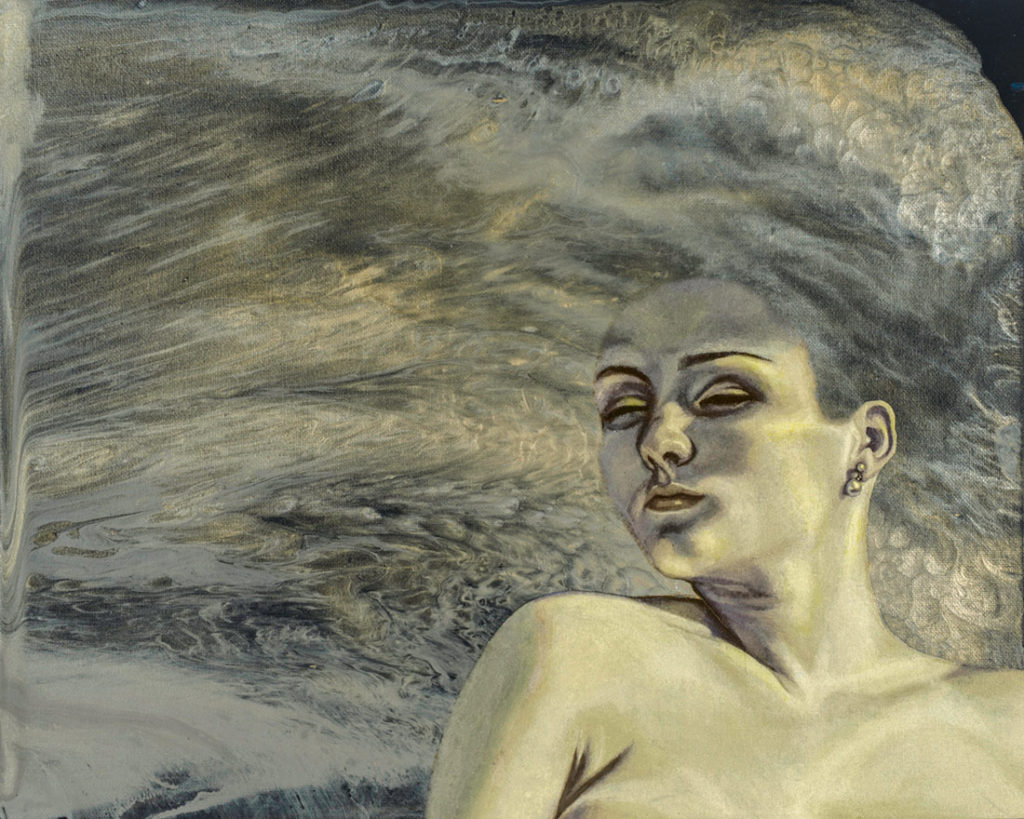
“Sorceress” Egg tempera, oil, acrylic, collage, mixed media on canvas board. 41 x 51cm
A.M.: Your career as a painter is awe-inspiring. You have exhibited internationally in respectable art fairs and museums, including XII Florence Biennale, Schneider Museum of Art, Ashland, Denver Art Museum, De Cordova Museum, Oakland Museum, Herbert F. Johnson Museum, along with a solo exhibition at the Rogue Gallery. From this productive experience of managing in the art field, what kind of conclusions did you come to, and what kind of advice can you give to the emerging artists trying to make their way to success?
R.G.: My experience encourages one never to stop working and to believe in the integrity of your vision. The most important skill you can acquire is to learn to draw. Otherwise, it will always be “the elephant in the room.”
I suggest to emerging artists not to worry about consciously creating a style. In my opinion, that would be putting the “cart before the horse.
” You are unique, and originality will prevail. If you give it time, your own style will emerge. Also, don’t be influenced too much with the stories of the monetary success of individual artists and the fabulous prices you read about at auctions, etc. Mostly, artists are ahead of their time.
By the time the art reaches the auction house and sells for vast sums of money, it has already been absorbed into society over an extended period of assimilation. Conversely, if you try to emulate the latest styles, you will already be lagging behind. The only way you can be current and original is to trust your sensibility and build on your passion and strengths. Acquire the resources you need.
As a working artist, it is crucial to surround yourself with those that respect and understand what you are doing and support and inspire you.
I have been lucky in this regard, with my husband, friends, family, and colleagues.
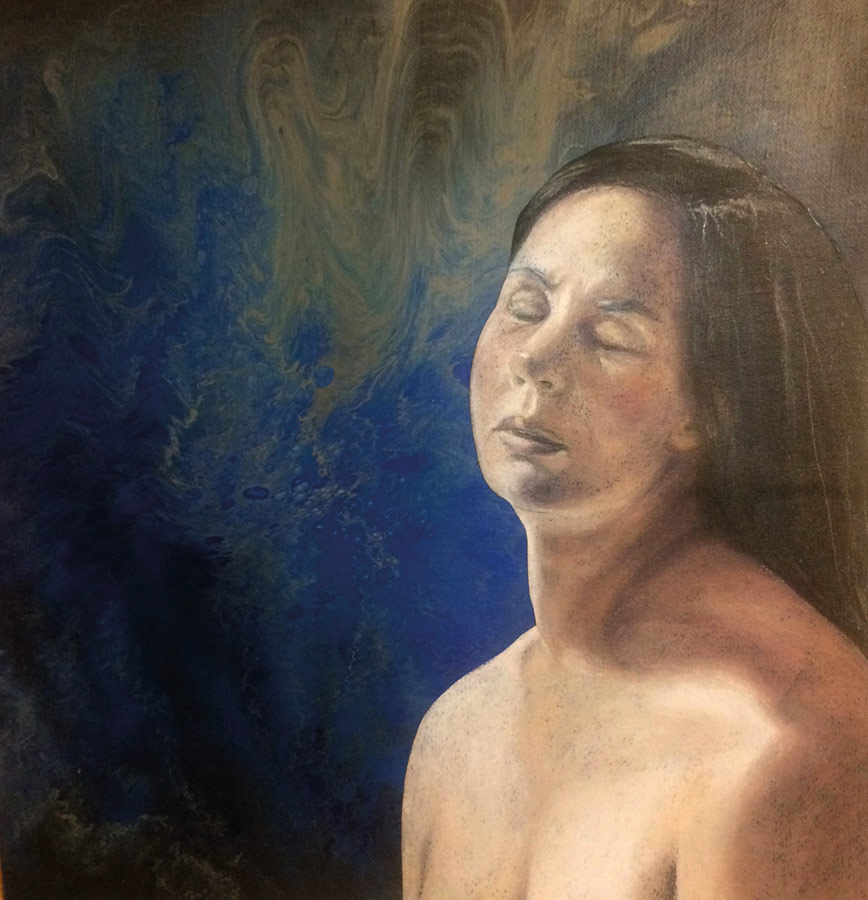
“Leda” Pastel, acrylic, collage, mixed media on canvas.
46 x 46cm
A.M.: Professionally, what’s your goal. What does the future hold? Do you have any ‘dream project’?
R.G.: I seek an expanding audience for my work in terms of exposure and recognition. My current participation in ART MARKET magazine is much in alignment with this goal. Thank you! Along with the dissemination of my work, my goals always address process and evolution. I have a plethora of ideas and inspirations, with only a fraction manifested. As it turns out,
I have a very vociferous muse, AKA “bossy,” and a developing pantheon of techniques and subjects. From there, I move forward, attentive to the strongest pull of the current, and hope it will bring me to that creative place that I call “home.”
As for my “dream project,” it would be to launch a current and, perhaps, traveling, retrospective in an appropriate and reputable space or institution. This way viewers might see the trajectory of my journey. . . its many links, themes, and evolving processes – much like a 3-D map unfolding, room to room.
“My recent work employs my realistic portraits in oil and egg tempera along with high flow application of acrylic. In this way, I transform and push the portrait towards a mysterious and expressive state. I never know how the elements will manifest in the immediacy of the process, which is intuitive and random. I am trying to break through the scrim of realistic portraiture and bring it towards another realm.
Rebecca Gabriel
My process combines realism and psychology with random forces of nature. When successful, the image conveys an authenticity that is contemplative, unique, and transformative”.
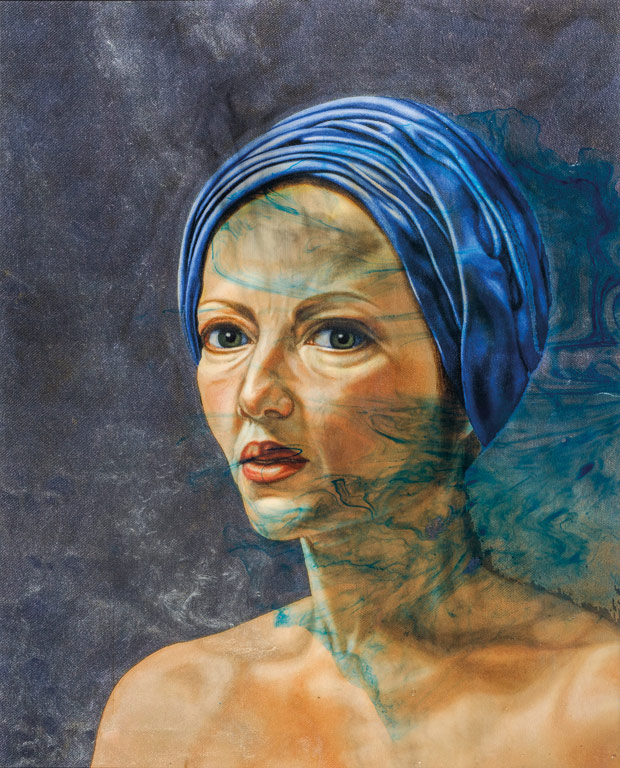
© All rights reserved.
“Vapors” egg tempera/oil, acrylic, mixed media on canvas.
61 x 46 cm
WEBSITE: www.rebeccagabriel.com
EMAIL: rebeccagabriel@aol.com
FACEBOOK: Rebecca Gabriel
Read The Full Article on Art Market Magazine Issue #46

